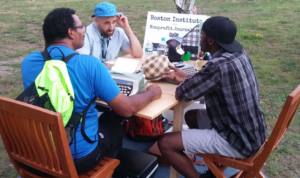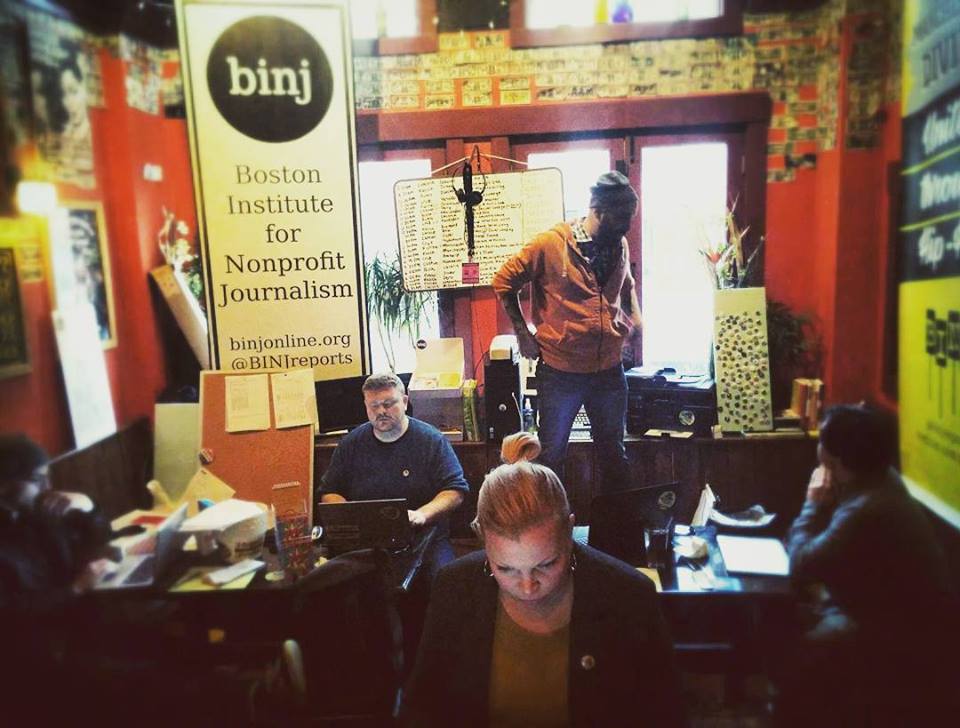Editor’s note: This is part of a collection of essays on how to reach new audiences by listening. We asked four journalists from across the country to explain approaches they’ve used to build trust with specific communities, particularly those who may be alienated or disengaged. Writing from Massachusetts, Chris Faraone describes how the Boston Institute for Nonprofit Journalism has created a simple physical presence in Boston neighborhoods.
When summarizing my first two years of running a nonprofit journalism shop in Boston, I often use the spot-on aphorism that necessity is the mother of invention.
That’s the best way to explain how, before we had real funding but needed to get our name out on the street and hit the ground reporting, my small team simply packed some folding chairs into a hatchback, filled a box with office supplies including an old-fashioned Rolodex, purchased an inexpensive carpet, and borrowed a desk to anchor a nomadic newsroom.
Our destination: a public common in the heart of Roxbury, one of Boston’s historically black neighborhoods where gentrification, among other critical issues like violent crime that I have covered intensely for years, is a primary concern. Our mission: meet community members, listen closely, and ascertain what people think is lacking in general coverage of their neighborhood.
That initial trial led to us setting up tables all over the place, from a Noam Chomsky event in a church to block parties in working class neighborhoods, with our team testing various ways to engage with strangers. We gave away free merchandise and used cool props like vintage typewriters to get people to sit at our desk.
Instead of just repeating the trade show procedure of requesting emails, we solicited story ideas. And leads. And sources for potential articles. Some participants wrote on the marker boards that we provided, while others asked for business cards and followed up afterwards. In one case stemming from that first pop-up experiment in Roxbury, a BINJ reporter wound up profiling a man whose story we first learned about in a curbside interview.
How pop-up newsrooms work
Prior to popping up on our own, I first encountered the idea while sitting in the audience of the Engage Local National Conference in June 2015. The Boston Institute for Nonprofit Journalism I was designing with my partners was still embryonic, and I had come to the New Jersey journalism summit to meet others who were also looking for solutions.
Even though BINJ was still just a baby back in 2015, I was already preaching the idea — my gospel — that far too many university-based journalism programs are walled off from the communities in which they are located. Besides being a disservice to neighborhoods, where schools often help fuel gentrification, the students are ill-served by an apparent lack of interaction with residents.
My ears perked up at the idea of a pop-up newsroom — what I’d soon come to understand as an initiative in which reporters basically set up shop, interact directly with folks in a social setting, and in certain cases even write and edit stories on laptops.
The inspirations at Engage Local came from speakers representing Montclair State University’s NJ News Commons and the Philadelphia-based Billy Penn, both of which had organized election night press hubs in public spaces. I took their ideas back to Boston, brainstormed ways to shape them for our readership, and got to popping up.
The rest is history. The history of journalism, that is. Corny as it sounds, the spirit of engagement my crew tries to harness hearkens to Newspaper Row, a 19th century Boston district in the crossroads known today as Downtown Crossing. Back then, barking tabloid hockers scratched headlines on giant chalkboards as the passersby dropped tips.
It may be something of a buzzword these days, but at its core engagement is a tool used by all media makers who value the voices of marginalized people. From Nellie Bly getting herself committed to live in a cold asylum, to Jonathan Kozol exposing decaying schools from the inside, many of my writing heroes have been bold civic engagement masterminds (and don’t get nearly as much credit as they deserve from media establishment types, but that’s another essay altogether).
Between the Billy Penn example and a grassroots media philosophy that I developed reading Kozol, Bly, and countless others while working for alternative weeklies, pop-up newsrooms were a natural extension to my repertoire, as well as a tangible sign of what we hoped BINJ would become. They also didn’t require significant funding, which was attractive in our early days since resources were hard to come by.
Impact and lessons
Though we were recognized for hosting pop-ups by some journalism blogs and peers, I didn’t realize just how radical our efforts were until a summer festival last year in the Jamaica Plain section of Boston. Our booth had chairs for people to relax in and was quite inviting. To promote a feature we had published about sustainable living arrangements, we made our space look like the footprint of a tiny house by spraying chalk on the ground in the outline of a small home.
As visitors asked our reporters about things like affordable housing and upcoming elections, one row over there was a much more professional-looking booth belonging to our city’s newspaper of record. Unlike our arrangement, though, they had no actual journalists for people to speak with — just a hired street team. No sharing. No meaningful exchanges. Whether intentional or not, the message that the legacy broadsheet was sending is that it wants money from subscribers, but not their thoughts, knowledge or ideas.
After watching festival-goers and Bostonians at various events learn about our articles by physically interacting with props, we started to design and build educational games from scratch. We developed a series of interactive activities based on BINJ stories and research, like one game in which people are asked to match cut-out heads of local politicians to a list of corporate contributions their campaigns have gorged on. We even had a holiday engagement carnival at a local brewery where the BINJ team was able to test multiple prototypes.
There have been occasions when our take on the pop-up is fully functional, with our reporters generating stories on the spot. One of my favorite examples is how BINJ covered the 2016 New Hampshire presidential primary, when we took over the front room of a bar in Manchester and designated it as a refuge for independent journos. Like our regular pop-ups, the makeshift newsroom in the field was a great place for media makers to get face time with locals. As important, though, was that alternative and grassroots journalists had a place to convene, trade tips, share resources and put strategies in place to help each other in the field.
In addition to securing scoops that they would have missed without such a communal hub, several writers and photographers who didn’t know each other previously wound up collaborating. We recently used a similar approach in our fleet coverage of mass demonstrations in Boston, and will continue fostering that group dynamic between freelancers.
We were asked by the American Press Institute to share our reflections on these pop-up trials, and to also offer any tips we have for those who are considering similar initiatives. The good news is that anyone can build on the ideas laid out here, whether or not there is funding involved. You don’t need a grant to get started — just a table and chairs and a desire to meet people.
We have had success bringing reporters who are good at listening, and with piggybacking an activity that is already happening — outdoor movie nights, crafts fairs, community days at cable access TV stations. We come ready to chat, with audio and video recording capability in case that it is needed and subjects are comfortable being taped.
Our team at BINJ is hard at work compiling a detailed resource outlining projects we’ve done so far, including pop-up newsrooms, that we believe will come in handy for reporting incubators all over the country — from those who we are already helping start their engines, to those who come to us from this point on looking for guidance. In the meantime, we recommend that journalists across the board, from tabloids to trade publications, go out there as often as possible and ask readers questions directly. They have a much better idea of what kind of reporting they would like to see than I do.
Chris Faraone can be reached by email at fara1@binjonline.org
Share with your network
Focused Listening
You also might be interested in:
The Houston Chronicle created small-scale experiments that tested how strategically work with a creator while navigating potentially thorny issues around ethics, control and impact. In this series, they walk you through what they did.
Every community has a commons — a park, a library, a garden — a shared space that only thrives when people care for it together. Our local information ecosystems are no different. At our recent Local News Summit, we asked the room: What does it mean to be gardeners, guards and stewards of the local information commons?
We know psychological safety might feel like a ‘nice to have,’ but what if the failure to create that safety is silently stalling your best ideas and alienating your next generation of leaders?





